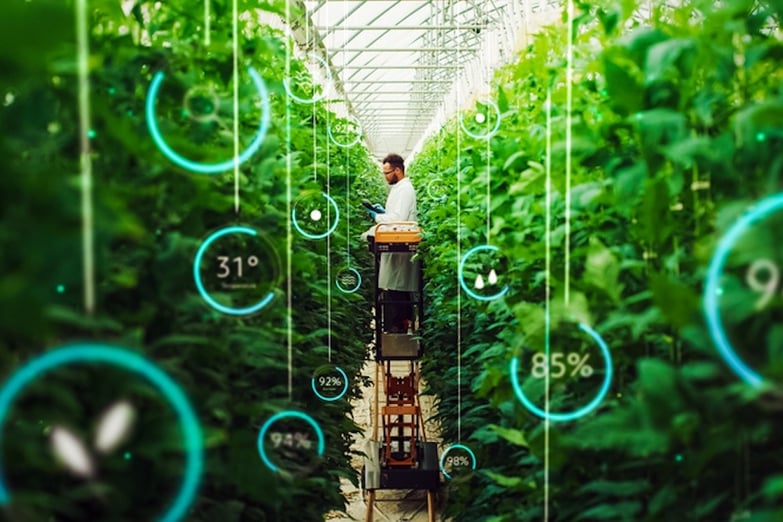Back to articles
How cellular IoT can improve agricultural yield and the lives of farmers

Agriculture has been a vital part of human history for over 12,000 years, marking a significant transition from hunting and gathering. Although the exact reasons for this shift are not clear, one theory suggests it was driven by the need for a more efficient way to obtain food.
Farmers are still facing this need today, while grappling with the challenges of exponential population growth and climate change. Today, roughly 1 billion people on the planet lack access to sufficient food – so even without future population growth and the impact of climate change, we need to improve our efficiencies and yields. Climate conditions are also continually shifting in ways that traditional farming can’t easily address.
Additionally, consumer expectations have evolved significantly in recent years, with many preferring to purchase food produced through ethical and sustainable growing practices. This often requires farmers to optimize the use of resources and reduce waste. In short, farmers are increasingly expected to achieve more with less.
The capabilities of precision farming
The latest advancement in agriculture is the development of “precision farming”. This system employs wireless connectivity, autonomous machines, drones, and data analytics to provide a detailed understanding of crops and livestock. Precision farming enhances resource efficiency, optimizes growing conditions to maximize yield, and reduces the need for human intervention —saving both time and money. Additionally, it helps pre-empt problems—for example, preventing flooding from burst irrigation pipes by using sensors to detect leaks before they escalate.
Asset monitoring is also crucial for farms, as tractors, harvesters, and irrigation systems are expensive and essential for operations. Over large areas of land, assets can be easily misplaced, improperly stored or damaged. Using technology to keep track of these assets helps farmers get the most from expensive equipment.
And it’s not only traditional farms that can benefit from this approach. Vertical farms—consisting of rows of plants stacked on shelves in a fully enclosed and controlled environment—can also use these techniques efficiently. In these farms, LED lights replace sunlight, closed-loop recycled water systems are used, and the protected environment eliminates the need for pesticides. According to Science Focus magazine, vertical farming can yield ten times more produce per given land area compared to traditional methods.
Another advantage of vertical farming—also known as Controlled Environment Agriculture (CEA) —is that the ability to grow food in the location it’s needed. This can significantly reduce transportation costs and minimize spoilage.
- Read more: Home-grown food production gets smart
Transmission across extended distances
Implementing smart farming presents several challenges. One major issue is transmitting data across the large distances typical of farms. While Bluetooth LE and mesh can help bridge some of the distance, there is a limit to the range these networks can reliably achieve.
An alternative to Bluetooth networks—and a technology that can be used effectively in combination with them—is cellular IoT. Devices like the Nordic’s nRF9151 System-in-Package (SiP)—which uses an LTE-M/NB-IoT modem—offer extended transmission distances of the order of kilometers, making them ideal for smart agricultural applications. Cellular IoT devices can transmit aggregated data—such as light, temperature, humidity, and soil moisture levels—directly to the Cloud for analysis, eliminating the need for expensive and complex gateways. The nRF9151 also features enhanced GNSS support, which aids in tracking key assets across large distances on the farm.
The nRF9151 SiP also includes built-in support for DECT NR+, a non-cellular radio standard recently included as part of the 5G standards by the ITU, operating on the dedicated, license-exempt 1.9 GHz DECT band. This standard is especially beneficial because it reduces deployment costs by allowing the creation of a private network through a private service provider, eliminating data charges. Alternatively, as DECT NR+ is comparatively easy to setup and run, a farmer could set up the network by themselves without the need for third party support.
For farmers requiring extensive monitoring, this standard is highly scalable, supporting anywhere from 100 to 1 million nodes within a single square kilometer and offering a range of up to three kilometers between nodes.
To enhance the data collection of associated sensors, the nRF9151 integrates with Nordic’s Cloud services, called nRF Cloud. nRF Cloud provides tools for onboarding, configuration, monitoring, and firmware-over-the-air (FOTA) updates, for example. The Cloud services support IoT device fleets throughout their lifecycle, ensuring maximum utilization.
Extended battery life
Battery life is crucial for most outdoor applications, which generally lack access to mains power. However, when wireless sensors are deployed across vast areas, making battery changes a major operation, its importance becomes even more significant. LTE-M and NB-IoT’s low-power characteristics make it ideal for devices that must operate over long distances and extended periods, such as sensors in smart agriculture.
The nRF9151 SiP is designed from the ground up to minimize power consumption, extending battery life. It takes full advantage of the low-energy possibilities associated with cellular IoT technologies, such as Power Saving Mode (PSM) and eDRX.
Additionally, the nRF9151 boasts a 20 percent smaller footprint compared to the nRF9161 SiP, making it ideal for space-constrained sensor or asset monitoring applications.
Low power 5G services, such as those supported by the nRF9151 SiP, help enable real-time data collection and analysis, allowing for more precise monitoring and management of crops and livestock. This leads to more informed decision-making, improved resource efficiency, and better overall farm management.
- Read more: Cellular IoT helps farmers use water wisely


